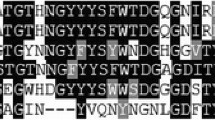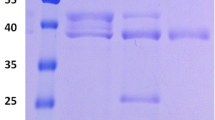Abstract
The OsmC-region (osmotically induced protein family) of the two-domain esterase EstO from the psychrotolerant bacterium Pseudoalteromonas arctica has been shown to increase thermolability. In an attempt to test if these properties can be conferred to another enzyme, we genetically fused osmC to the 3′-region of the family 8 xylanase encoding gene xyn8 from P. arctica. The chimeric open reading frame xyn8-OsmC was cloned and the chimeric protein was purified after heterologous expression in Escherichia coli. Xyn8 and Xyn8-OsmC showed cold-adapted properties (more than 60% activity at 0°C) using birchwood xylan as the preferred substrate. Maximal catalytic activity is slightly shifted from 15°C (Xyn8) to 20°C for Xyn8-OsmC. Thermostability of Xyn8-OsmC is significantly changed in comparison to wild-type Xyn8. The OsmC-fusion variant showed an apparent decrease in thermostability between 40 and 45°C, while both proteins are highly instable at 50°C.


Similar content being viewed by others
References
Al Khudary R, Stösser NI, Qoura F, Antranikian G (2008) Pseudoalteromonas arctica sp. nov., an aerobic, psychrotolerant, marine bacterium isolated from Spitzbergen. Int J Syst Evol Microbiol 58:2018–2024
Al Khudary R, Venkatachalam R, Katzer M, Elleuche S, Antranikian G (2010) A cold-adapted esterase of a novel marine isolate, Pseudoalteromonas arctica: gene cloning, enzyme purification and characterization. Extremophiles 14:273–285
Altschul SF, Gish W, Miller W, Myers EW, Lipman DJ (1990) Basic local alignment search tool. J Mol Biol 215:403–410
Bailey MJ (1988) A note on the use of dinitrosalicylic acid for determining the products of enzymatic reactions. Appl Microbiol Biotechnol 29:494–496
Bradford MM (1976) A rapid and sensitive method for the quantitation of microgram quantities of protein utilizing the principle of protein-dye binding. Anal Biochem 72:248–254
Brennan Y et al (2004) Unusual microbial xylanases from insect guts. Appl Environ Microbiol 70:3609–3617
Britton HTK, Robinson RA (1931) CXCVIII—universal buffer solutions and the dissociation constant of veronal. J Chem Soc 458:1456–1462
Chandrasekaran C, Betrán E (2008) Origins of new genes and pseudogenes. Nat Educ 1
Collins T, Meuwis MA, Stals I, Claeyssens M, Feller G, Gerday C (2002) A novel family 8 xylanase, functional and physicochemical characterization. J Biol Chem 277:35133–35139
Collins T, Gerday C, Feller G (2005) Xylanases, xylanase families and extremophilic xylanases. FEMS Microbiol Rev 29:3–23
Collins T et al (2006) Use of glycoside hydrolase family 8 xylanases in baking. J Cereal Sci 43:79–84
Egorova K, Antranikian G (2007) Biotechnology. In: Garret RA, Klenk H-P (eds) Archaea—evolution, physiology and molecular biology. Blackwell, USA, pp 295–321
Emanuelsson O, Brunak S, von Heijne G, Nielsen H (2007) Locating proteins in the cell using TargetP, SignalP and related tools. Nat Protoc 2:953–971
Guo B, Chen XL, Sun CY, Zhou BC, Zhang YZ (2009) Gene cloning, expression and characterization of a new cold-active and salt-tolerant endo-beta-1,4-xylanase from marine Glaciecola mesophila KMM 241. Appl Microbiol Biotechnol 84:1107–1115
Henrissat B (1991) A classification of glycosyl hydrolases based on amino acid sequence similarities. Biochem J 280:309–316
Hoesl MG et al (2011) Lipase congeners designed by genetic code engineering. ChemCatChem 3:213–221
Honda Y, Kitaoka M (2004) A family 8 glycoside hydrolase from Bacillus halodurans C-125 (BH2105) is a reducing end xylose-releasing exo-oligoxylanase. J Biol Chem 279:55097–55103
Khandeparker R, Numan MT (2008) Bifunctional xylanases and their potential use in biotechnology. J Ind Microbiol Biotechnol 35:635–644
Lee CC, Kibblewhite-Accinelli RE, Wagschal K, Robertson GH, Wong DW (2006) Cloning and characterization of a cold-active xylanase enzyme from an environmental DNA library. Extremophiles 10:295–300
Liu CC, Schultz PG (2010) Adding new chemistries to the genetic code. Annu Rev Biochem 79:413–444
Rehse PH, Ohshima N, Nodake Y, Tahirov TH (2004) Crystallographic structure and biochemical analysis of the Thermus thermophilus osmotically inducible protein C. J Mol Biol 338:959–968
Sambrook J, Fritsch E, Maniatis T (2001) Molecular cloning: a laboratory manual, 3rd edn. Cold Spring Harbor, New York
Sunna A, Antranikian G (1997) Xylanolytic enzymes from fungi and bacteria. Crit Rev Biotechnol 17:39–67
Sunna A, Moracci M, Rossi M, Antranikian G (1997) Glycosyl hydrolases from hyperthermophiles. Extremophiles 1:2–13
Turner NJ (2009) Directed evolution drives the next generation of biocatalysts. Nat Chem Biol 5:567–573
van den Broek LA, Lloyd RM, Beldman G, Verdoes JC, McCleary BV, Voragen AG (2005) Cloning and characterization of arabinoxylan arabinofuranohydrolase-D3 (AXHd3) from Bifidobacterium adolescentis DSM20083. Appl Microbiol Biotechnol 67:641–647
Van Petegem F, Collins T, Meuwis MA, Gerday C, Feller G, Van Beeumen J (2003) The structure of a cold-adapted family 8 xylanase at 1.3 Å resolution. Structural adaptations to cold and investigation of the active site. J Biol Chem 278:7531–7539
Waino M, Ingvorsen K (2003) Production of beta-xylanase and beta-xylosidase by the extremely halophilic archaeon Halorhabdus utahensis. Extremophiles 7:87–93
Yoon KH, Yun HN, Jung KH (1998) Molecular cloning of a Bacillus sp. KK-1 xylanase gene and characterization of the gene product. Biochem Mol Biol Int 45:337–347
Yourno J, Kohno T, Roth JR (1970) Enzyme evolution: generation of a bifunctional enzyme by fusion of adjacent genes. Nature 228:820–824
Zhang S, Zhang K, Chen X, Chu X, Sun F, Dong Z (2010) Five mutations in N-terminus confer thermostability on mesophilic xylanase. Biochem Biophys Res Commun 395:200–206
Acknowledgments
The authors thank Rami Al Khudary and Nele Stösser for the identification of pBK-CMV-Xyn8. Torben Rehn and Ute Lorenz are thanked for the help with some experiments and Mazen Rizk for critically reading the manuscript.
Author information
Authors and Affiliations
Corresponding author
Additional information
Communicated by H. Santos.
Rights and permissions
About this article
Cite this article
Elleuche, S., Piascheck, H. & Antranikian, G. Fusion of the OsmC domain from esterase EstO confers thermolability to the cold-active xylanase Xyn8 from Pseudoalteromonas arctica . Extremophiles 15, 311–317 (2011). https://doi.org/10.1007/s00792-011-0361-8
Received:
Accepted:
Published:
Issue Date:
DOI: https://doi.org/10.1007/s00792-011-0361-8




